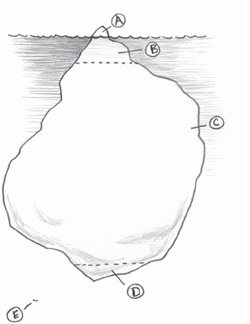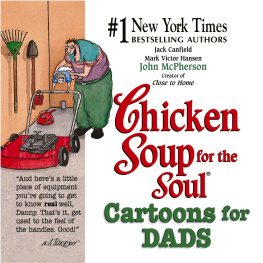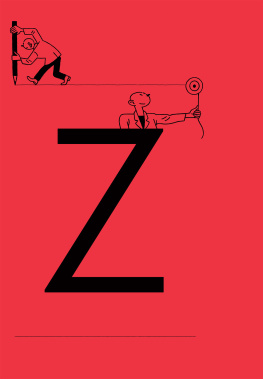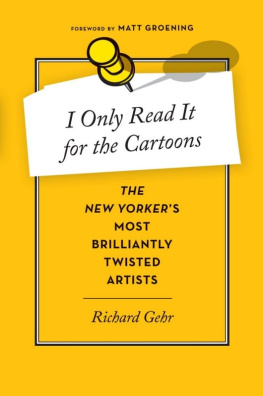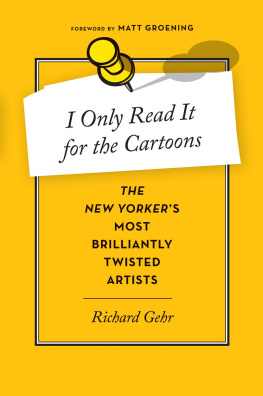THE BEST OF THE
REJECTION COLLECTION
293 Cartoons That Were Too Dumb, Too Dark, or Too Naughty for The New Yorker
Rescued by Matthew Diffee
FOREWORD BY ROBERT MANKOFF
Workman Publishing, New York
DEDICATION
In memory of J. B. (Bud) Handelsman and Leo Cullumwonderful cartoonists and even better friends
This book is neither authorized nor sponsored by The New Yorker.
Copyright 2011 by Matthew Diffee
All rights reserved. No portion of this book may be reproducedmechanically, electronically, or by any other means, including photocopyingwithout written permission of the publisher. Published simultaneously in Canada by Thomas Allen & Son Limited.
Library of Congress Cataloging-in-Publication Data
eISBN 9780761168669
The best of the rejection collection : 293 cartoons that were too dumb, too dark, or too naughty for the New Yorker / rescued by Matthew Diffee ; foreword by Robert Mankoff.
p. cm.
ISBN 978-0-7611-6578-1 (alk. paper)
1. American wit and humor, Pictorial. 2. New Yorker (New York, N.Y.: 1925) I. Diffee, Matthew. II. New Yorker (New York, N.Y. : 1925)
NC1428.N47B47 2011
741.56973--dc23
2011024089
Design by Sue Macleod with Janet Vicario
Much of the material in this book originally appeared in The Rejection Collection and The Rejection Collection, Vol. 2 by Matthew Diffee (published by Simon Spotlight Entertainment, a division of Simon & Schuster, in 2006 and 2007, respectively).
constitutes an extension of this copyright page.
Workman books are available at special discounts when purchased in bulk for premiums and sales promotions as well as for fund-raising or educational use. Special editions or book excerpts also can be created to specification. For details, contact the Special Sales Director at the address below, or send an e-mail to specialmarkets@workman.com.
WORKMAN PUBLISHING COMPANY, INC.
225 Varick Street
New York, NY 10014-4381
www.workman.com
CONTENTS
FOREWORD
BY ROBERT MANKOFF
If memoryor, more accurately, Googleserves me correctly, it was Keats who proclaimed: Beauty is truth, truth beauty,that is all / Ye know on earth, and all ye need to know. Well, let me tell ye, Keats was dead wrong. Certainly, hes dead; we can agree on that. But my main point is that if you want to know what makes something funny, its not beauty. Look, the Mona Lisa is beautiful, but until Marcel Duchamp put a mustache and goatee on her, she was no fun at all. Funny isnt about beautyits about freedom. Sometimes that freedom leads to disrespect, ridicule, and outright offensiveness. To see the truth of that, you dont have to look any further than this collection of cartoons that happily exploit all that is vile for the sake of a smile.
Furthermore, if youre like me, many of the offensive, obscene, disgusting cartoons here will actually make you laugh out loudand, in some cases, cause incontinence, nausea, and fainting. So before looking at these cartoons, ask your doctor if incontinence, nausea, and fainting are right for you.
This collection is yet more proof that bad taste and humor are not strange bedfellows but intimate partners whose down-and-dirty doings often delight us against our better judgment, our scruples, and our politically respectable attitudes.
But whereas cartoonists (at least the ones Ive known, including myself) are not known for their better judgment, their scruples, and their respectability, The New Yorker is. And since Ive been the cartoon editor of the magazine for the past ten years, a patina of The New Yorkers respectability has unavoidably rubbed off on me. Its just a veneer, of course, but after a decade its quite thick and, according to my dermatologist, very difficult to remove. Besides, the procedure isnt covered by my health plan.
But thick veneer notwithstanding, if it were really up to just me, some of these cartoons would probably have made it into The New Yorker, offending not only the little old lady in Dubuque but perhaps even the cross-dressing CEO in Manhattan. But none of these cartoons did, in fact, make it into The New Yorker. Thats because others at the magazine have better judgment, more scruples, and greater respectability than I do, as evidenced by the fact that they rejected this cartoon of my own.

Hey, my eyes are up here!
How these cartoons got into the hands of the editor of this collection, Matthew Diffee, cartoonist and former friend, I dont know, and he wont tell, even under the threat of extraordinary rendition. So theres nothing to be done but enjoy them and be damned.
INTRODUCTION
Welcome to The Best of the Rejection Collection. In this book youll find a bunch of wonderfully awful and some awfully wonderful rejected New Yorker cartoons. Theyre not really New Yorker cartoons (after all, The New Yorker rejected them), but they are cartoons by The New Yorker cartoonists. Im one of those cartoonists. My job is to come up with cartoons and pitch them to the magazine. The magazines job is to reject almost all of those cartoons. What happens to those rejected ideas? Nothing, unless you count gathering dust as something. Are the rejected cartoons any good? That depends on what you mean by good. Good for The New Yorker? No, probably not. Good for a laugh? Certainly. In fact, if you ask the cartoonists, some of the rejected ones are the flat-out funniest cartoons weve ever done. But theyre different than what youre used to seeing from us. The ones you see in the magazine are the ones The New Yorker chose to show you. If we were doing the choosing you might end up with a magazine full of cartoons like this one.

Id say my biggest influence is probably Pollock.
You might think, like I did when I submitted it, that a gag like this could totally be in The New Yorker, but you, like I, would be wrong. Sure, it makes a highbrow reference to an abstract expressionist painter whose work you have to know in order to get the joke, but its also a cartoon about bird poop. Oddly, The New Yorker doesnt seem to go for that kind of thing. I assume thats why they passed on it. (Of course I dont really know for sure why this or any of the cartoons in this book were rejected. I have only my hunches. Ive made a list of those and illustrated each with an example from my own stack of rejects. Youll find them at the end of this introduction.)
Let me take just a second here and put all this rejection business into perspective for you. The cartoons you see in The New Yorker are only a small percentagethe tip of the iceberg. We cartoonists are lucky if they take one of the ten ideas we pitch each week. Its a 90 percent rejection rate, but its actually worse than that because our final ten, the ones we deem good enough to sketch up and pitch, are the tip of an even bigger iceberg. Well, its the same iceberg, and I guess it cant technically be the tip since I just called the other part the tip. Its the next part below the tip. If it were a piece of candy corn, it would be the dark orange part. (And speaking of that, why would anyone name candy after a vegetable? Makes no sense.) Tell you what. Forget the candy corn. Stay with me on the iceberg. In fact, let me draw it.
